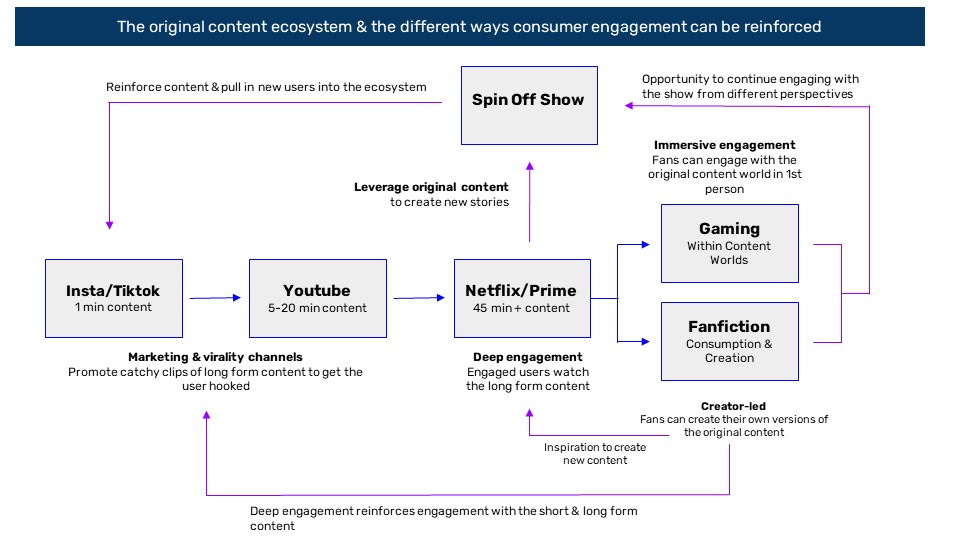[#7] Content 3.0 | Key Drivers in the Evolution of Content
By Ambika & Devki Pande
What is Content 3.0?
To understand Content 3.0, one must understand the evolution from Web 1.0 to Web 3.0. Web 1.0 consisted of static webpages, where the user read off the webpage for information. Web 2.0 enabled 2-way communication: where the user could read information, and input items. This gave rise to collaboration and communities, but on centralised platforms like Facebook and Instagram, where the platform owned the user generated content. In Web 3.0, you own the information that you input.
Content 3.0 therefore, is the unsteady content landscape- in - flux which is absorbing not just the aftershocks of the evolution from Web 2 to Web 3, but is also inclusive of evolutions that are flowing from changing consumer behaviour.
Consumer behaviour and content offerings
There are multiple disruptive aspects to Content 3.0, which is leading to its unsteady nature.
The first aspect is that platforms are decentralised. This means that they are owned not by a centralised platform, but by distributed servers, and - similar to blockchain - by the network members. In an ideal case of decentralisation, the creators/users would own the platform/network that they are plugged into. This also means that decisions are taken in a more democratised fashion (by group consensus), so policies are passed because the majority agrees.
The second is the creator-generated content model, which puts the power back in the hands of the creators. Since creators own their content, they are no longer tied to a single platform, and the rise of the multi-platform creator has enabled creators to build communities, which are built on the strength of personal brand identity and good content, rather than simply followings.
The third is the changes in the way content is being seen, consumed and delivered, stemming from consumer related changes. As a result,new ways of consumption are coming to the fore. In a nutshell, what this means is that the need for stories remains unchanged, but the way the audience is now engaging with them is changing, because of things like reduction of attention span, increasingly busy lifestyles, the growing demand for immersion and interactivity, and a plethora of available content. This is resulting in stories grappling for new forms and avatars to exist in, resulting in interesting medleys and nexuses.
The fourth is AI
Disruptions taking place around Content 3.0
There’s an interesting insight from the PWC media and entertainment report, which states that people are still willing to engage with longer formats – even hours-long content – as long as it comes in short form packaging. And if you look at what’s happening with platforms like Twitter, TikTok and Instagram, this seems to be true.
Changes in content consumption & delivery
Reelshorts: How short is too short?
Imagine you’re scrolling through instagram, and you find a clip that makes you want to watch more. That’s the content that Reelshorts capitalises on. Snackable content - but for long form scripted content.
In Reelshorts, each episode is 1-minute long - which means that one or two scenes makes an episode. Now, this format isn’t new, at least for creator-led models. Many TikTok creators employ this tactic via “story time” videos that stretch across multiple posts (the hashtag #StoryTime currently has 227.2 billion TikTok views). Similarly, long form stories on Twitter are told in bite sized pieces, from hashtag to hashtag. What’s interesting about this phenomenon is how creator led platforms are using this approach when it comes to scripted content.
ReelShorts has marketed itself as the next generation of HD streaming platform that aims to change the way you watch and consume T.V shows. It’s an innovative way for aspiring filmmakers - creators to share their work with the world.
The nexus of publishing and gaming
Another interesting disruption is Chapters, which focuses on the nexus between publishing and gaming. Set up by Crazy Maple studios, the goal was to help traditional publishers re-engage with their audiences. Crazy Maple licences the story from the publisher/author, and builds multiple scenarios and outcomes - including avatars, choice-based storylines. It’s a way of merging existing fiction with fan-fiction, allowing the reader/gamer to move through the chapters in a character avatar of their choosing.
Gaming and the Metaverse: The demand for immersion and interactivity
The best way to describe the metaverse would be to experience the internet in a 3D fashion. Today, the screen has become another plane of reality to exist in. Rather than sectioning up content into SFV and long form videos, and social media, and shorts, the more apt way to look at it is as an interconnected tapestry of media that one can step into, and move in between.
We’re already seeing technology around this. The newest tool built on this concept is Apple’s VR headset. It’s essentially a spatial computer that introduces a fully three-dimensional user interface controlled by the most natural and intuitive inputs possible — a user’s eyes, hands, and voice. You can check it out here.
The EY-FICCI ‘23 report stated that Indians will spend more on online gaming than on films. This could be the play that big content houses like Netflix are going for. What if we export IP to gaming? Netflix has at least 5 gaming IP films either in the planning or the production stage, and is betting big on gamifying its popular original series such as Narcos and Stranger Things. This could be the ecosystem play that we talked about in previous articles: hook consumers in with original content, and then build out a 3D ecosystem that consumers can engage with through AR/VR video games.
The increased use of AI in content creation
AI promises hyper-personalisation at scale. AI, not just in content, but also in social media. Its potential in content usage is just beginning. Using ChatGpt to come up with stories (which a Bollywood producer has done), is just the tip of the iceberg. AI is already being used to generate digital avatars for sales and content purposes - like news anchors for popular channels.
Creator generated written content is now being picked up by production houses.
Fanfiction is wildly popular among internet communities, and well-known fanfic sharing sites include Wattpad, Archive Of Our Own (AO3) and Fanfiction.net. AO3 in particular is so widely used that it has developed its own terminology and tropes. In fact, this is now being seen as a pool of ideas that can be produced and made into full feature films and shows. Some notable examples are 50 shades of grey - a fanfiction based on the Twilight series, and the more recent Culpa Mea, which is a wattpad story picked up by PrimeVideo and made into a film, which has received a lot of traction in your online and social media spaces. And fanfiction has a big reader pool, sources say that more than 100 Million people across the world consume fanfiction.
There is massive scope here for AI. AI is already being used to generate images, basis inputs. It will soon be able to generate video content of regular and fanfiction stories. Imagine being able to feed in a story, adding parameters (based on personal requirements), and generating video content of your favourite books & stories.
4. Conclusion
Putting together the Content 3.0 evolution, and the changes in content, the way forward seems to be cross pollination of media industries, and immersive AI powered user owned and generated content in various formats.
The ones that will revolutionise the landscape are the ones who bring their use-case to an existing industry. Tiktok, for example, known for micro content, is entering the publishing game, with its parent company setting up a publishing arm. Will Tiktok export its model into traditional reading? How will Instagram export its reels format into packaging long form videos for the user?
There is even a greater push towards unscripted content than ever before, with powerhouses like BBC revealing it as part of their 2024 strategy, and the leading Swedish streamer Viaplay cutting down scripted content and focusing more on local unscripted shows. How will these powerhouses - known more for great scripted shows - apply principles of fiction to non-fiction? Since ‘social’ media is essentially non-fiction, like a reverse Reelshorts, will they also take their cues from reels and tiktoks?
Content 3.0 could also be unlocked by studying how millennials and Gen Z use screens. The way one used to move from location to location, Gen Z and millennials now move from screen to screen. This means that content must be developed in such a way that Gen Z seeks it out in different forms of media. According to a Bain and Company report, 50% of the younger generation chose to play a specific video game after watching a show, and 60% wish their favourite tv show had video game experiences. Content 3.0 seems to be a convergence between different forms of media, in a way that hasn’t existed before.
This appears to be the playing ground for the next couple of years. We will see if this settles down into a more stabilised Content 4.0 form.





